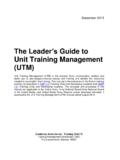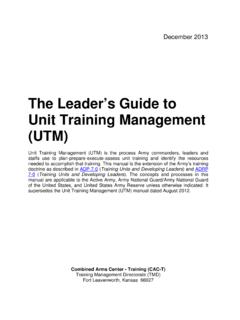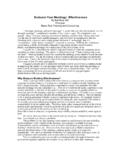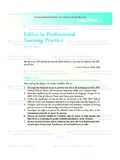Transcription of The Leader’s Guide to After-Action Reviews (AAR)
1 December 2013 The Leader s Guide to After-Action Reviews (AAR) An AAR is a professional discussion of a training event that enables Soldiers/units to discover for themselves what happened and develop a strategy for improving performance. Facilitators provide an overview of the event plan (what was supposed to happen) and facilitate a discussion of what actually happened during execution. This leader s Guide supports the Army training doctrine in ADP 7-0 and ADRP 7-0 (Training Units and Developing Leaders) and T he Le ad e r s Gu ide to Unit T ra inin g Ma n a gem e nt (UTM).
2 The concepts and processes in this manual are applicable to the Active Army, Army National Guard/Army National Guard of the United States, and United States Army Reserve unless otherwise indicated. It supersedes the Leader s Guide to after - action Reviews (AAR) dated August 2012. Combined Arms Center - Training (CAC-T) Training Management Directorate (TMD) Fort Leavenworth, Kansas 66027 Unit Training Management (UTM) December 2013 NOTE: This leader s Guide is also available in The Leader s Guide to Unit Training Management (UTM) dated December 2013, appendix D.
3 This leader s Guide is formatted to optimize 2-sided printing. The proponent for The Leader s Guide to After-Action Reviews (AAR) is the United States Army Combined Arms Center (CAC). The preparing agency is the Training Management Directorate (TMD) within CAC Training (CAC-T). CAC T is subordinate to the United States Army Combined Arms Center. TMD is the Army lead for training management. Send comments through the Army Training Network (ATN) at using the Ask-A-Trainer feature and using the term AAR in the subject line.
4 2 Training Management Directorate (TMD), Fort Leavenworth, KS 66027 Unit Training Management (UTM) December 2013 After-Action Reviews (AAR) Purpose AARs are a guided analysis of an organization s performance, conducted at appropriate times during and at the conclusion of a training event or operation with the objective of improving future performance. It includes a facilitator, event participants, and other observers (ADRP 7-0). The AAR provides valuable feedback essential to correcting training deficiencies. Feedback must be direct, on-the-spot and standards-based.
5 AARs are a professional discussion of a training event that enables Soldiers/units to discover for themselves what happened and develop a strategy for improving performance. They provide candid insights into strengths and weaknesses from various perspectives and feedback, and focus directly on the commander s intent, training objectives and standards. Leaders know and enforce standards for collective and individual tasks. Task standards are performance measures found in the respective training and evaluation outlines (T&EO) found on the Army Training Network (ATN), the Digital Training Management System (DTMS) and the combined Arms Training Strategies (CATS all available on ATN).
6 Leaders avoid creating the environment of a critique during AARs. Because Soldiers and leaders participating in an AAR actively self-discover what happened and why, they learn and remember more than they would from a critique alone. A critique only gives one viewpoint and frequently provides little opportunity for discussion of events by participants. The climate of the critique, focusing only on what is wrong, prevents candid and open discussion of training events and stifles learning and team building. Leaders make on-the-spot corrections and take responsibility for training Soldiers and units.
7 This occurs when leaders understand the commander s intent, the tasks to be trained and exercise the principles of mission command to improve Soldier, leader, and unit performance. Units that conduct AARs and empower subordinates to make on-the-spot corrections are more effective. Effective AARs are a reflection of the commander and his active role in unit training. AARs foster an environment of trust, collaboration, initiative, and cohesion necessary among Soldiers and leaders in decentralized operations. Soldiers learn and understand the commander s intent and act decisively while accepting prudent risks.
8 AARs conducted during training include the same four parts as AARs conducted during operations: review what was supposed to occur. The facilitator, along with the participants, Reviews what was supposed to happen. This review is based on the commander s intent, training objectives and tasks to train. This information is usually found in the operations order or on the training schedule. 3 Training Management Directorate (TMD), Fort Leavenworth, KS 66027 Unit Training Management (UTM) December 2013 Establish what happened. The facilitator and participants determine what actually occurred during the training event, phase or the operation.
9 The leader attempts to gather as many views or perspectives (OPFOR, squad leader, team leader, rifleman, etc) as feasible and possible. This helps to establish a common understanding of the operation/event. Leaders then understand the complexity of an event and work to solve complex, ill-defined problems quickly. Determine what was right or wrong with what happened. Participants then establish the strong and weak points of their performance based on the commander s intent and performance measures. The facilitator guides discussions to ensure maximum input that is operationally sound and relevant to the training event.
10 Determine how the task should be done differently next time. The facilitator guides the unit in self-determining how the task(s) might be performed more effectively in the future. The unit identifies problems and provides solutions as well as identifies who is responsible for making the recommended changes. Additionally, the facilitator guides the discussion to determine if there is a more effective way to train the tasks to achieve the commander s intent. Types of AARs There are two types of AARs, formal and informal. A formal AAR is resource-intensive and involves the planning, coordination, and preparation of the AAR site, supporting training aids, and support personnel.










